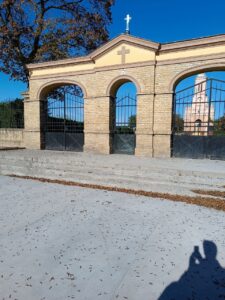History of Catholicism in Subotica
Subotica, a picturesque city located in northern Serbia, has a rich tapestry of cultural and religious influences. Among these, Catholicism has played a significant role in shaping the community’s identity and traditions. This article delves into the history of Catholicism in Subotica, exploring its origins, development, and the vibrant community that continues to thrive today.
History of Catholicism in Subotica
The roots of Catholicism in Subotica can be traced back to the medieval period when the region was part of the Kingdom of Hungary. The establishment of the Catholic Church in the area coincided with the arrival of Hungarian settlers, who brought their faith with them. By the 13th century, Subotica had developed into a significant settlement, and the Catholic Church began to take a more prominent role in the community. The construction of the first church in the area marked the beginning of organized Catholic worship, laying the groundwork for future growth.
As the centuries progressed, Subotica became a melting pot of various ethnic groups, including Hungarians, Croats, and Serbs, each contributing to the city’s diverse religious landscape. The Catholic Church played a crucial role in fostering a sense of unity among these groups, often serving as a common ground for worship and community gatherings. The establishment of the Diocese of Subotica in 1804 further solidified the Church’s influence, allowing it to cater to the spiritual needs of the growing population.
The 19th century was a pivotal time for Catholicism in Subotica, as the city experienced rapid industrialization and urbanization. This period saw an influx of immigrants, which enriched the local culture but also posed challenges for the Catholic community. The Church responded by expanding its outreach efforts, building new churches, and establishing educational institutions. This proactive approach helped maintain the faith’s relevance in a changing society, ensuring that Catholicism remained a cornerstone of Subotica’s identity.
The Role of Catholic Institutions
Catholic institutions have been instrumental in shaping the religious and social fabric of Subotica. The establishment of schools, hospitals, and charitable organizations by the Catholic Church has had a lasting impact on the community. These institutions not only provided essential services but also served as a means of promoting Catholic values and education. The Church’s commitment to social welfare has fostered a sense of solidarity among residents, reinforcing the importance of community support.
One of the most notable institutions is the Franciscan Monastery, founded in the 18th century. This monastery has been a center for spiritual life and education, attracting many young people to the priesthood and religious life. The Franciscans have played a vital role in the preservation of Catholic traditions and have been active in various social initiatives, including outreach programs for the marginalized. Their presence has helped to maintain a vibrant Catholic community in Subotica.
In recent years, Catholic institutions in Subotica have adapted to the changing needs of society. With the rise of secularism and a more diverse population, the Church has sought to engage with the broader community while remaining true to its mission. Initiatives such as interfaith dialogues and community service projects have helped bridge gaps between different religious and cultural groups, showcasing the Catholic Church’s commitment to inclusivity and cooperation.
Contemporary Catholic Community
Today, the Catholic community in Subotica is a dynamic and diverse group, reflecting the city’s rich cultural heritage. With a mix of ethnicities and backgrounds, the Church continues to serve as a unifying force, offering a sense of belonging to its members. Regular Mass services, religious festivals, and community events foster a strong sense of identity and continuity, allowing residents to connect with their faith and each other.
The Catholic Church in Subotica also embraces modernity, utilizing technology and social media to reach a broader audience. Online services, virtual prayer groups, and social media outreach have become essential tools for engaging with younger generations. This adaptability has allowed the Church to remain relevant in a rapidly changing world, ensuring that its message resonates with both longtime parishioners and newcomers alike.
Moreover, the Catholic community in Subotica actively participates in various social and charitable initiatives, addressing pressing issues such as poverty, education, and healthcare. By collaborating with local organizations and government agencies, the Church demonstrates its commitment to social justice and the well-being of all residents, regardless of their faith. This proactive approach not only strengthens the Catholic community but also enhances the overall quality of life in Subotica.
The history of Catholicism in Subotica is a testament to the resilience and adaptability of faith in a diverse and evolving society. From its humble beginnings to its current role as a vital part of the community, the Catholic Church has left an indelible mark on the city’s cultural landscape. As Subotica continues to grow and change, the Catholic community remains a beacon of hope and unity, ensuring that its rich traditions endure for generations to come.


